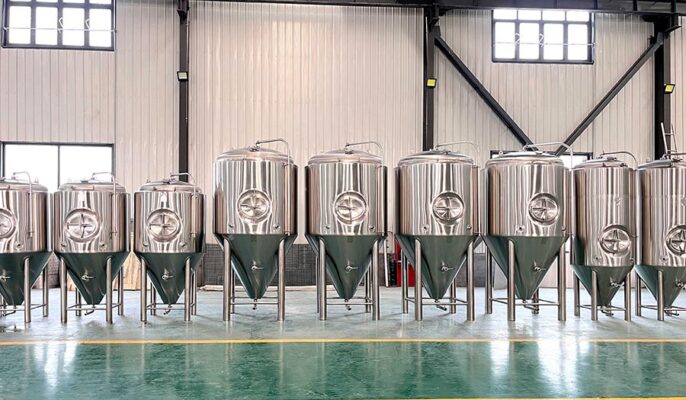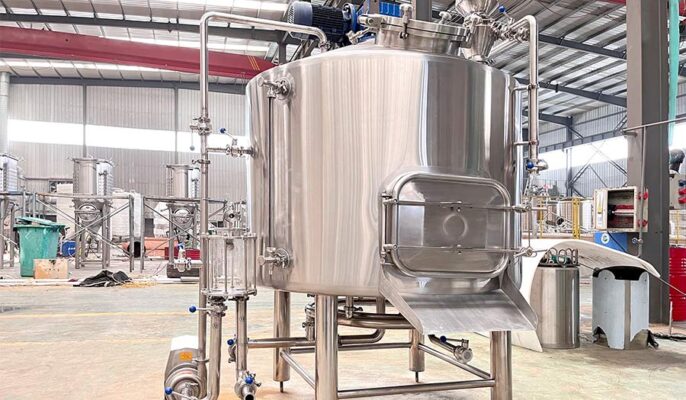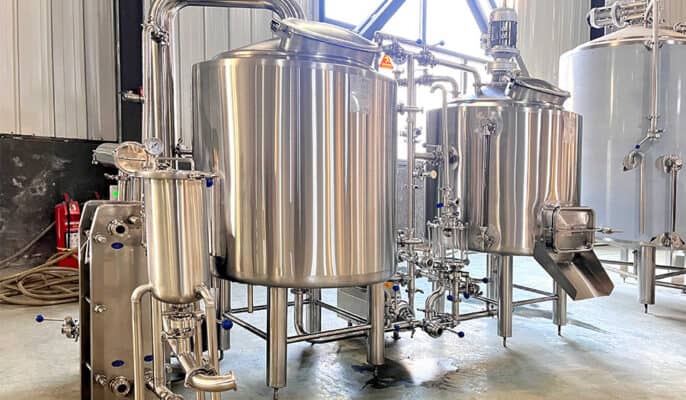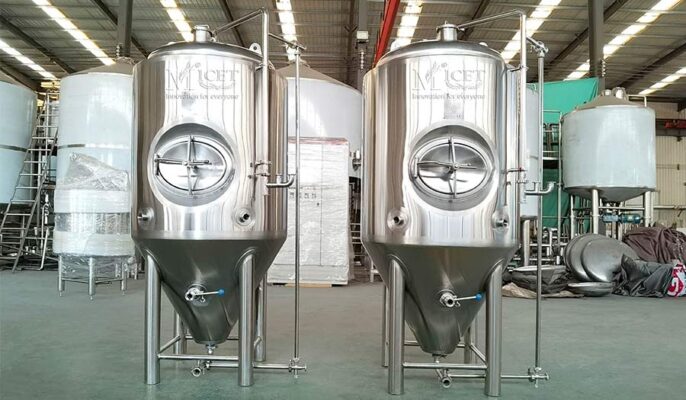kombucha brewing equipment is a fermented tea drink that has become incredibly popular thanks to its tangy flavor and potential health benefits. Brewing kombucha at home requires some specialized equipment to properly control the fermentation process. This guide will provide an overview of the essential kombucha tools needed from start to finish.
Kombucha Brewing Equipment Types
The main types of kombucha equipment include:
| Equipment | Function |
|---|---|
| Brewing container | Fermentation vessel to house kombucha culture |
| Airlock | Allows gas to escape while keeping outside air out |
| Spigot | Dispenses finished kombucha from fermenter |
| Thermometer | Monitors fermentation temperature |
| Bottles | Stores flavor-infused 2F kombucha |
| Siphon | Transfers 1F kombucha to bottles for 2F |
Kombucha Brewing Process Equipment Needs
Kombucha fermentation involves two steps, each requiring certain gear:
1F – First Ferment
The first ferment produces the raw kombucha. Equipment is needed to:
- Brew and steep tea
- Mix in sugar
- House SCOBY in sweet tea for primary fermentation
- Control air exposure
- Monitor temperature
An open-topped brewing container, airlock, thermometer and SCOBY culture are minimally required.
2F – Second Ferment
The second ferment is for flavoring and carbonation after 1F is complete. To bottle condition kombucha:
- Siphon finished 1F kombucha
- Mix in fruit juice, herbs or other flavorings
- Store bottles airtight for 2-3 days
Bottles, siphons, and ingredients to add flavors are necessities in this phase.
Kombucha Fermenter Size and Capacity
| Fermenter Size | Brew Capacity |
|---|---|
| 3 gallons | Can yield 12 16-oz bottles per 1F batch |
| 5 gallons | Can yield 48 16-oz bottles per 1F batch |
| 7 gallons | Can yield 84 16-oz bottles per 1F batch |
Yields will vary based on fermentation factors
When sizing a fermentation vessel, consider:
- Desired quantity of kombucha
- Available brewing space
- Number of SCOBY cultures
Larger batches need more SCOBY surface area for successful fermentation.
Customizable Kombucha Setup Design and Layout
Kombucha brewing systems can be customized by:
- Number of fermenters
- Attachments like spigots
- Shape – cylindrical or square
- Tap system for bottling
Multi-stage setups allow uninterrupted brewing cycles by staggering 1F and 2F in different containers.
Consider ease of cleaning, drainage, and ergonomics when designing a layout. Locate near water supply and drainage for convenience.

Where To Buy Kombucha Brewing Equipment
Starter Kits: A Springboard for Beginners
For brewing novices, starter kits provide a convenient launchpad. These kits typically include essential equipment like glass jars, SCOBY (Symbiotic Culture of Bacteria and Yeast), organic sugar, tea, and brewing instructions. Popular options include The Kombucha Shop’s Starter Kit or the Deluxe Kombucha Brewing Kit, both well-equipped and beginner-friendly.
Beyond the Basics: Building Your Brewing Arsenal
As you gain confidence, explore individual components to customize your setup. Opt for larger brewing vessels like a 2-gallon glass jar for bigger batches. Invest in a hydrometer to track sugar content and fermentation progress. For continuous brewing, a spigot-equipped container simplifies the process. Don’t forget funnels, cheesecloth, and swing-top bottles for bottling your kombucha creations.
Online Retailers: A World of Kombucha Supplies
The internet is your oyster when it comes to kombucha brewing supplies. Online retailers like Amazon, Northern Brewer, and Homebrew Shop carry a vast array of equipment, SCOBYs, and flavorings. Explore their virtual shelves for brewing jars, funnels, hydrometers, and other essentials. Look out for kombucha-specific websites like The Kombucha Shop or Kombucha Kamp, offering dedicated kits and brewing resources.
Local Homebrew Stores: Hands-on Help and Community
Don’t underestimate the power of your local homebrew store. These havens for fermentation enthusiasts often stock kombucha supplies alongside beer and wine brewing equipment. The knowledgeable staff can answer your questions, offer recommendations, and guide you through the brewing process. Additionally, many stores host workshops and demonstrations, fostering a sense of community and shared passion.
Specialty Stores: Catering to Niche Preferences
For specific needs or unique preferences, explore specialty stores. Health food stores may carry organic SCOBYs, teas, and sugars suitable for kombucha brewing. Local tea shops might offer loose-leaf blends specifically geared towards kombucha enthusiasts. Don’t be afraid to ask around – you never know what hidden gems you might discover!
Kombucha System Installation and Operation
| Task | How To | Tips |
|---|---|---|
| Set Up | Clean and sanitize all equipment; assemble airlocks, spigots per instructions | Ensure seals are airtight |
| Brewing | Steep tea, add sugar, pour into fermenter, top with SCOBY/starter tea according to recipe | Use freshly boiled & cooled tea |
| Fermenting | Keep 1F batch around 75°F out of sunlight for 7-30 days until acidity reaches desired level | Maintain constant appropriate temperature |
| Bottling | Gently siphon kombucha avoiding intake of yeast sediment | Don’t introduce oxygen by splashing |
| Flavoring (2F) | Add juice, herbs, etc. once first ferment complete; leave 2-3 days | Use freshly prepped fruits/flavors |
| Storage | Refrigerate finished kombucha; compost extra SCOBYs | Keep air exposure minimal |
| Clean-up | Wash all equipment with non-antibacterial soap after use | Thoroughly dry to prevent mold |
Follow brewing principles and food safety guidelines for best results.
Kombucha Brewer Supplier Evaluation Criteria
When selecting a kombucha equipment provider, compare on:
| Criteria | Evaluation Guidance |
|---|---|
| Materials | Medical-grade stainless steel preferred |
| Construction | Leak-proof seals, durable joints |
| Features | Size/capacity options available |
| Ease of use | Simple setup, cleaning, bottling |
| Price | Balance affordability with functionality |
| Product range | Offers various fermenters, accessories |
| Service | Responsiveness if issues arise |
| Reviews | Positive feedback from customers |
| Certifications | Meets food/beverage manufacturing standards |
Prioritize leak-proof capability, stainless steel parts, smooth surfaces, and accessories like spigots. Balance price against longevity – more expensive often means higher performance and longevity.

Pros and Cons of Kombucha Brewing Equipment
Pros of Kombucha Equipment
Consistency is Key: Mastering the Art of Brew
Imagine this: you’ve concocted the perfect kombucha recipe, your first sip is a symphony of flavor, but subsequent batches fall flat. Enter dedicated equipment. Using the right tools, like brewing jars with spigots, allows for repeatable, controlled fermentation. Gone are the days of messy siphoning and inconsistent results. Each batch becomes a testament to your skill, not haphazard chance.
Beyond Bubbles: Unlocking Flavor’s Full Potential
Think kombucha is just sweet and tangy? Think again! With the right equipment, you become a flavor alchemist. Invest in a hydrometer to precisely control sugar levels, leading to perfectly carbonated batches or drier, kombucha-vinegar style creations. Experiment with different teas, fruits, and herbs, knowing your equipment can handle even the most spirited fermentations.
Efficiency Meets Sustainability: Brewing Smarter, Not Harder
Let’s face it, continuous brewing with makeshift mason jars can be cumbersome. But dedicate a continuous brewing system with a spigot, and kombucha flows effortlessly. Less cleaning, less waste, and a steady stream of your favorite bubbly – what’s not to love? Plus, reusable bottles and swing-top lids eliminate single-use plastics, making your kombucha habit an eco-conscious one.
Safety First: Peace of Mind in Every Sip
When it comes to fermentation, hygiene is paramount. Food-grade glass jars, stainless steel funnels, and proper sanitation tools ensure contamination risks are minimized. Peace of mind comes with knowing your equipment is designed for safe and healthy kombucha brewing.
The Joy of Craft: Brewing Becomes a Ritual
Forget the supermarket aisles. Owning your kombucha journey starts with owning your equipment. The act of measuring, brewing, and bottling becomes a mindful ritual, connecting you to the magic of fermentation. And when you raise a glass to your own creation, the satisfaction is unparalleled.

cons of Kombucha Equipment
While brewing your own kombucha can be a rewarding and delicious adventure, it’s crucial to approach it with informed eyes. Beyond the enticing benefits of dedicated equipment lie potential drawbacks that warrant consideration. Let’s explore the other side of the bubbly coin and examine the cons of investing in kombucha brewing tools.
The Cost Conundrum: Brewing on a Budget
Let’s be honest, kombucha kits and individual equipment add up. From brewing vessels to hydrometers, the initial investment can seem daunting, especially for budget-conscious beginners. Consider carefully if your kombucha habit justifies the upfront cost, or if starting with simple mason jars and readily available ingredients might be a wiser first step.
Space Invaders: Finding Room for Fermentation Frenzy
Kombucha brewing can quickly take over your countertop or pantry. Large brewing vessels, bottles, and equipment require dedicated space, which might be scarce in smaller kitchens. Assess your available storage before diving in, or opt for space-saving solutions like continuous brewing systems.
The Learning Curve: From Novice to Ninja (Eventually)
Mastering kombucha takes time and practice. While equipment simplifies procedures, it doesn’t eliminate the learning curve. Be prepared for trial and error, potential contamination mishaps, and the patience required to hone your brewing skills. Don’t be discouraged by initial hiccups; view them as stepping stones to becoming a kombucha ninja!
Cleaning Conundrum: Maintaining the Sparkly Standard
Maintaining sterile equipment adds another layer of responsibility to your kombucha journey. Regular cleaning and sanitation are crucial to prevent contamination, but they can also feel like a chore. Evaluate your commitment to thorough hygiene before investing in equipment, as neglecting this aspect can compromise the safety and quality of your brews.
The Allure of Simplicity: Sometimes, Mason Jars Suffice
For casual kombucha enthusiasts, the allure of simplicity shouldn’t be underestimated. Starting with basic equipment like mason jars and readily available ingredients allows you to experiment and enjoy the process without significant financial or space commitment. Remember, delicious kombucha doesn’t always require fancy tools.
FAQ
What are the absolute necessities for brewing kombucha?
The minimum needed is a fermentation vessel, SCOBY, starter liquid, tea, sugar, and a cloth cover. Acids from the culture and tea prevent outside contamination. Other equipment can optimize the process.
Which material is best for fermentation vessels?
Stainless steel, glass and food-safe plastic all work. Stainless offers the most durability and ease of cleaning over repeated uses. Glass is impervious but less durable. Food-grade plastic is affordable but can scratch over time.
Should I get a kit or buy pieces separately?
Kits simplify getting started with validated equipment combos versus assembling piecemeal. As experience grows, customize with preferred fermenter types, flavors, etc. Some kits even provide the SCOBY.
How many fermentation vessels should I have?
At minimum, one fermenter and bottles for 2F are needed. Using separate primary and secondary fermenters lets batches continually cycle. Additional vessels let you experiment with flavor combinations.
What temperature is best for kombucha fermentation?
The ideal range is 75-85°F. Temperatures below 70°F slow fermentation. Above 86°F risks contamination. Maintain a stable temperature for consistent results.






I really liқе it when folks get together and share ideas.
Great website, stick with it!